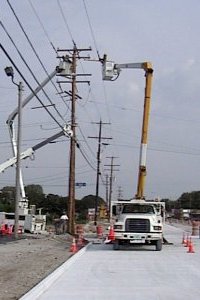 A permit is required to work in the right-of-way of an Interstate, U.S. or state highway. All of these numbered highways make up the state highway system.
A permit is required to work in the right-of-way of an Interstate, U.S. or state highway. All of these numbered highways make up the state highway system.
The permitted work may consist of, but is not limited to:
- Excavating
- Placing fill materials
- Grading
- Paving
- Surveying
- Boring under a highway
- Installing an overhead utility facility
- Blocking and detouring traffic
A permit must be obtained from the Wisconsin Department of Transportation (WisDOT)
prior to the start of any work, and a copy of the permit (either paper or electronic) must be at the work-site
at all times.
Under Wis. Stat.
s. 86.07(2)(a), the maintaining authority of a highway is also the permitting authority. WisDOT issues permits on most numbered highways. However, many cities and villages maintain segments of state and U.S. highways located within their municipal boundaries. These segments are called
connecting highways. Check with WisDOT or the municipality to verify which agency has the permitting authority. Permits for utility work on WisDOT railroad property and state highway detours are not controlled by this statute.
Permits
Select a link below for information related to the specific topic.
Permit contacts
Select a link below for a statewide map of permit contacts in each region office.
 As-built plans, ROW plats, and soils information
As-built plans, ROW plats, and soils information
A new interactive app is available to anyone doing business with WisDOT and will be especially helpful when developing ROW permit plans and drawings. The As-built Record Management System (ARMS) is an Arc GIS Map that displays all WisDOT as-built plans, right-of-way plats, or soils documents for completed projects. To access documents in ARMS, external users must create a MyWisconsin ID and use it each time they login. Additional document information may be found on the ARMS app as well as user guidance.
Please note the information includes copies of documents WisDOT developed for its use. Official recorded copies of Transportation Project Plats and conveyance documents are available from the applicable county Register of Deeds office.
To locate a document once you are in the ARMS app:
- Click on the Map Layers button in the upper righthand corner to toggle on and off record types that you want to view
- Zoom into the area of interest
- Click on a colored line segment. A dialog box will display with the documents (records) available at that location. In the example below, the upper righthand corner shows this is record 1 of 3. Use the < > buttons in the upper lefthand side to toggle between document. If a plat is available, "Right-of-way Plat File" will have a view link. Click on "View" to open the plat.


Work zone use of green lamps (lights)
Wis. Stat.
s. 347.26(7) allows WisDOT, county highway departments, and municipal highway departments to use flashing green lights while working on any highway for safety purposes. The concept is to better distinguish those vehicles from contractor and other vehicles/equipment. You may have seen flashing green lights on county snowplows and other vehicles while performing maintenance work on state highways.
Contractor vehicles and equipment
cannot use flashing green lights. The use of flashing (and strobe) white or amber lights is still permissible under Wisconsin law and encouraged to warn motorists of work zone activity. A special permit provision will be placed on all WisDOT-issued utility permits of this requirement.
On March 21, 2024, Wis. Stat. s. 347.26(9) was created under
2023 Wisconsin Act 155. This allows utility vehicles parked in the roadway or on the shoulder to use flashing green lamps only while engaged in restoring utility service that is outside the normal parameters of general maintenance or construction when damage or interruption of service has been caused to utility facilities by adverse weather or other events.
Work zone requirements
WisDOT implemented the following work zone requirements in January 2020 for utility and other ROW permits on all state highways as a way of increasing worker safety and striving for consistent application of signs, devices, flagging, etc.:
Work zone questions may be directed to the region work zone engineers listed at the bottom of this
webpage.
Work zone training courses
WisDOT has a number of online training
courses available through its LearnCenter for use by anyone interested in learning about work zone operations.
Work zone training questions may be directed to
Emily Silverson, Traffic Operations Engineer.